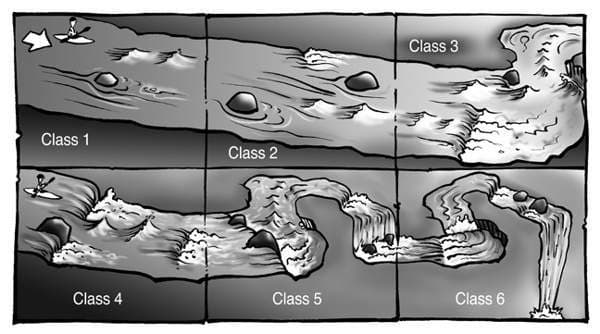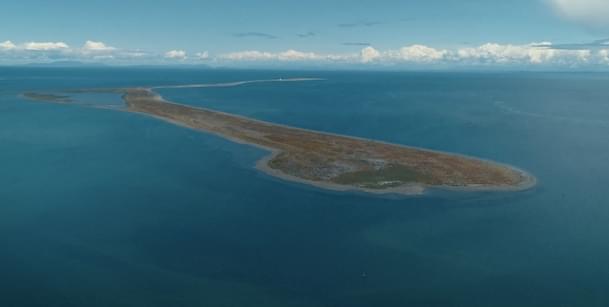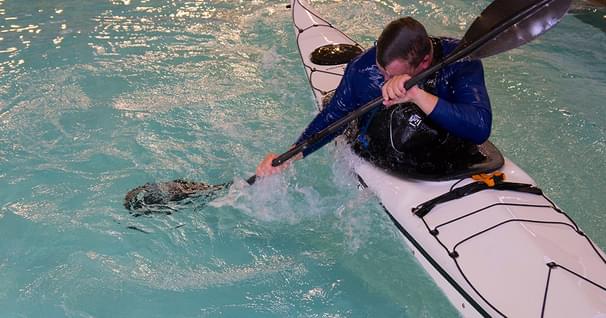River Classifications
Whitewater is rated on a scale of increasing difficulty from Class 1 to Class 6. This classification system provides a useful guide to the technical difficulty of a river, but there are so many other variables that can have a huge impact on the difficulty or danger of a river.
- Is it continuous in nature or drop and pool?
- Is the water warm or freezing in temperature?
- How remote is the run and how far away is help?
- Can you walk out if need be, or is it in a canyon?
- Is portaging an option for all rapids, or are you committed to running everything?
As you can see, there can be massive differences between two rivers of the same class. For this reason, it's your responsibility to find out more about any river you're considering paddling. For many areas, there are guidebooks with detailed descriptions and images of the rivers, and more of these are available each year. It's always a good idea to pick one of these up. You can also ask questions on On-line chatboards or stop in at the local retailer for information. You can never be too well informed.
The classification system is still very useful for giving a river a general level of difficulty. It must be accepted that this system is in no way an exact science, and that it's open to interpretation. Here are some general guidelines for the whitewater classification system.

TAHE 10'6 & 11'6 SUP-YAK Inflatables
2-in-1 Kayak & Paddle Board complete packages for single or tandem use.
Class 1 (Easy): Fast-moving current with small waves and few obstructions that are easily avoided. Low-risk. Easy self-rescue.
Class 2 (Novice): Straightforward rapids with wide-open channels that are evident without scouting. Occasional manoeuvring is required. Trained paddlers will easily avoid any rocks or medium-sized waves. Swimmers are seldom injured.
Class 3 (Intermediate): Rapids with moderate, irregular waves, strong eddies and currents. Complex manoeuvres and good boat control are required. Major hazards are easily avoided. Scouting is recommended for inexperienced paddlers. Self-rescue is usually easy and injuries to swimmers are rare.
Class 4 (Advanced): Powerful, turbulent, and predictable rapids with large, unavoidable waves and holes or constricted passages. Fast and reliable eddy turns and precise boat handling are needed to navigate safely through. Scouting is necessary, and rapids may require "must-make" moves above dangerous hazards. Strong Eskimo roll highly recommended, as there is a moderate to high risk of injury to swimmers. Self-rescue is difficult, so skilled group assistance often needed.
Class 5 (Expert): Extremely long, obstructed, or violent rapids with exposure to substantial risk. Expect large, unavoidable waves and holes, or steep, congested chutes. Eddies may be small, turbulent, difficult to reach, or non-existent. Reliable Eskimo roll, proper equipment, extensive experience, high level of fitness and practiced rescue skills essential for survival. Scouting highly recommended, but may be difficult. Swims are very dangerous and rescues are difficult.
Class 6 (Extreme): These runs exemplify the boundaries of difficulty, unpredictability and danger, and have almost never been attempted, if ever. The consequences of errors are very severe and rescue may be impossible. Only expert teams with ideal conditions and extensive safety systems should ever consider these rapids.
Ken Whiting was the 1997/98 World Whitewater Freestyle Champion. He has produced an award-winning series of instructional kayaking books and DVDs, and leads kayaking trips to Chile. Look for his latest book 'The Ultimate Guide to Whitewater Kayaking', and video 'The Ultimate Guide to Sea Kayaking'. Check out www.helipress.com
Related Articles
What are the lighting requirements for paddle craft being operated at night or in periods of reduced…
Dungeness Spit from above, with the New Dungeness Lighthouse in the distance Dungeness…
Driving a car safely involves much more than merely focusing only as far ahead as the taillights of…
Mention “pool session” and the first image that pops into most kayakers minds is a class in how to roll.…




